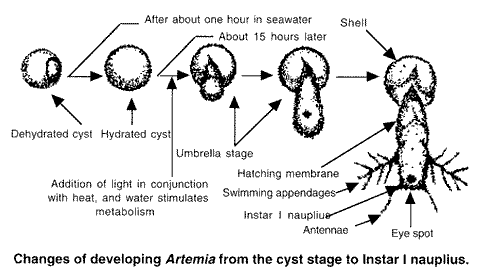
Brine Shrimp....Counter Point
by Gary Sutcliffe
In a recent Killie Krap, Norm and Susan discussed their method of hatching brine shrimp. They asked for comments from members that used other methods. While my methods are similar, there are some differences in the hatching container, water and harvesting method. They are based on my two fundamental personality traits: laziness and frugality (cheap).
I also use an inverted soda bottle container. Instead of putting an air hose connection in the cap to supply air, I simply screw the cap on tightly. This has some advantages. One is that when you take it to the sink to clean it, you don’t have to be sure the hole is plugged so the water won’t leak out. It is also simpler to construct.
Air is supplied through a glass tube. The air hose goes over one end, and the other end is stuck down through the water to the very bottom. This keeps the eggs and shrimp in constant suspension.

The air tube is pulled out at harvest time and the shrimp settle to the bottom. I use a turkey baster to remove the concentrated shrimp from the bottom of the hatching container. They are filtered through a clean white handkerchief stretched over a small plastic cup. I scrape the shrimp off with a toothpick and swish it in the fry tank.
I don’t rinse the shrimp before feeding. The amount of salt left will be negligible. I raise fry in tanks ranging from 2.5 gallons to a continuous flow system with a 25 gallon sump. With anything approaching reasonable water changes, the salt concentration build up will not be significant. In many cases, especially with Nothos, I add salt to the tanks anyway.
For hatching solution I use a heaping tablespoon of solar salt. This is the salt I use in the water softener, and it is very inexpensive since I buy it in 80 lb. bags. Norm used a higher salt solution that included Epsom salts. With the current cost of brine shrimp eggs, it is worth doing a little experimenting with hatching solutions to improve the hatching rate.
Several years ago I bought a number of 1 pound cans of shrimp eggs for $12 each. What a bargain that turned out to be! I just opened my last can a month or so ago, so the reality of current prices will hit me before long. Despite the long storage time, I have not noticed a decrease in hatching rates. I think my storage method is a factor in that.
I try to minimize the egg’s exposure to air. I punch a small hole in the top with a small nail to open a can. A plastic cover seals the top when I am not pouring out eggs, and the can is stored in the freezer. I use a small jar with a screw top lid to hold enough eggs for a few weeks use. It is also stored in the freezer. I refill the small jar when it is empty. This reduces the number of times the bulk of the eggs are exposed to warm and moist air.

Depending on the number of fry I have, I use between one half to one teaspoon of eggs for the hatching. During the winter when the basement fish room is cooler, the eggs typically hatch in about 36 hours. That decreases during the warmer months. Besides baby brine shrimp, I also feed my fry micro worms, vinegar eels and powdered dry foods. I also start very small fry out on green water.